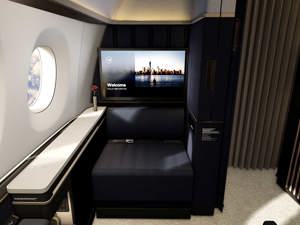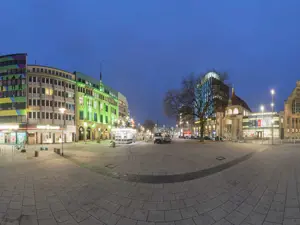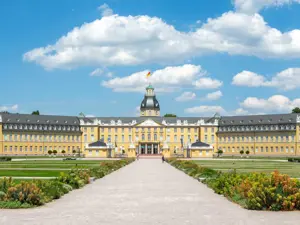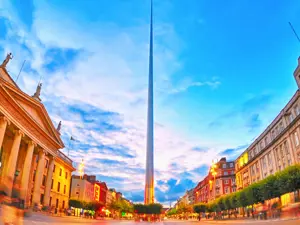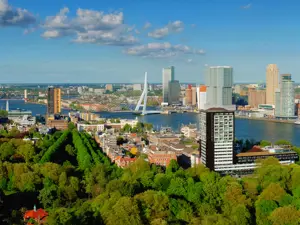The historic city on rocky mountain
Nuremberg’s name was derived from its position (Nuorenberc means rocky mountain), but its most important honour is that it was once the headquarters of an important dynasty, the Hohenzollern, who established the town as the first city-state of Holy Roman Empire and made it magnificent.
It is a city of imperial palaces and splendid churches; today, it is also a busy industrial centre known primarily for the manufacture of toys and each year holds the world’s most important toy fair. The second largest city in Bavaria after Munich, with half a million inhabitants, Nuremberg, capital of the Franconia region, is a fascinating city on the banks of the River Pegnitz, surrounded by hills and with a splendid old town enclosed by four kilometres of walls.

The Castel of Nuremberg. Copyright © Sisterscom.com / Shutterstock
A massive building dominates from above, the Imperial Castle, which from the tenth century century was the residence of the Counts of Hohenzollern and later, in the mid fifteenth century, become a military base. It is still one of the most important medieval fortifications in Europe. The underground passages of the castle house the unique and unmissable Art Bunker Museum, situated at a depth of 24 metres, which was created at the beginning of World War II to safeguard important works of art.
The vitality emanating from the city makes it one of the most popular destinations in Europe: millions of tourists visit it and numbers are increasing year on year.
The historic center of Nuremberg
With modern centre, Nuremberg also has numerous old traditions. These include the chimes of the bells of the Church of Our Lady at 12 o’clock every day. This beautiful Gothic building still sounds to commemorate the decree of the Golden Bull, the first form of constitutional law in the Holy Roman Empire, which was established by Charles IV in 1356.

Nuremberg. Historic centre. Copyright © Sisterscom.com / Shutterstock
The Beautiful Fountain of Nuremberg
And in the same square, brought to life during the year with aromatic and colourful markets of every type, is the Schöner Brunnen (Beautiful Fountain), a monument of extraordinary beauty, which rises up forming a pierced Gothic spire 19 metres tall and is embellished with 40 statues that represent the world view of the Holy Roman Empire, a work which due to its value was covered in cement during World War II to protect it from bombing.

Nuremberg. The Beautiful Fountain. Copyright © Sisterscom.com / Shutterstock
Nuremberg is a city of art which glories in being the birthplace of Albrecht Dürer, one of the most famous German painters and engravers. It also has a series of prestigious museums, filled with some of the most important works in Germany: the Nuremberg Municipal Museum, which is located in on large building that once belonged to merchants of the late Renaissance era, Albrecht Dürer’s House, the Toy Museum, Tucher Mansion Museum, as well as those that commemorate events - not always positive - of the Second World War, events - such as the persecution of the Jews - which, however, the city has never accepted.

Nuremberg. Copyright © Sisterscom.com / Shutterstock
The events that bring the city to life during the year are many and varied, from Rock im Park and Organ Week to Blaue Nacht, the night of art and culture, and Klassik Open Air, not forgetting the German-Turkish Film Festival, one of the largest and most popular of southern Germany.
This city, which was devastated by events during the war and then faithfully reconstructed, still expresses an enjoyment for life: in the night spots, in the elegant shopping streets, in the cuisine, rich in intense, wholesome flavours, in the wines and in its special beer - an opportunity for conviviality. Much prized are its sausages, in particular wurst, which, it seems, was invented here. Meat is the most consumed food with the local dish being bratwurst, a grilled sausage made of beef and pork. Nuremberg is also famous for its gingerbread, which can be enjoyed with mulled wine at the city’s Christmas Market, one of the world’s most famous.
Text by Anna Glik
Updated by Alisè Vitri
Avion Tourism Magazine
Photos: Copyright © Sisterscom.com, Shutterstock
Copyright © Sisterscom.com
Video: tourismus.nuernberg.de
Tourism Board
www.tourismus.nuernberg.de
www.germany.travel
Partnership with Booking.com
Where to sleep in Nuremberg
 Nuremberg. Copyright © Sisterscom.com / Shutterstock
Nuremberg. Copyright © Sisterscom.com / ShutterstockNuremberg is a welcoming city and offers different possibilities for accommodation.
To find the ideal hotel and the best offers you can do a search for the stars but also for districts or landmarks.
DISTRICTS
Hotels in the districts
LANDMARKS
Hotels in tourist areas
AIRPORT
Hotels near the airport
WHERE TO GO in Nuremberg
Monuments in Nuremberg

Copyright © Sisterscom.com / Shutterstock
IMPERIAL CASTLE
Once the seat of the Hohenzollern Dynasty and, for long periods, of the Emperors of the Holy Roman Empire, the castle guards over the city of Nuremberg with solid walls and tall towers. The interiors feature rooms and chapels well worth visiting, one of which houses a cross by Veit Stoss, the city’s greatest Renaissance painter, sculptor and engraver. The Knights’ Hall and Imperial Hall are interesting with beautiful frescoed ceilings. The castle also houses the Kaiserburg Museum, which houses ancient weapons, as well as the imperial apartment with the Emperor’s rooms.
www.kaiserburg-nuernberg.de

Copyright © Sisterscom.com / Shutterstock
CHURCH OF ST. SEBALDUS
Dedicated to the patron saint of the city, a nineth century monk who preached around Nuremberg, the church is impressive inside due to its high cross vaults. It houses the tomb of the saint, a masterpiece by Peter Vischer the elder, who worked there for years together with his five sons. It is, together with the Church of St. Lawrence and the Church of Our Lady, one of the city’s most prestigious buildings. The striking style features Romanesque elements from the early construction and solemn Gothic elements added during later work.
www.sebalduskirche.de

Copyright © Sisterscom.com / Shutterstock
BEAUTIFUL FOUNTAIN
A stop to admire the 40 very colourful statues that surround the limestone fountain and represent Philosophy, the seven Liberal Arts, the 4 Evangelists, the Church Fathers, the 7 Prince-electors and the Prophets, is a must.
Don’t forget to spin the two brass ring on the south-west side of the fountain: they are supposed to bring good luck.

Copyright © Sisterscom.com / Shutterstock
CHURCH OF OUR LADY
This is the most important church in Nuremberg, which was commissioned by Charles IV as an imperial chapel in 1361. It exhibited for the first time the imperial insignia of the Holy Roman Empire. It became a Protestant church after the Reformation, but was returned to the Catholic Church a few centuries later and remains a Catholic place of worship today.
www.frauenkirche-nuernberg.de

Copyright © Sisterscom.com / Shutterstock
CHURCH OF ST. LAWRENCE
This imposing Gothic construction with two belfries of 81 metres is known for its artistic double door with statues and engravings of the life of Jesus. Inside the elaborate choir are sumptuous stained glass windows and a marvellous masterpiece of sculpture by Veit Stoss, “The Angelic Salutation”, in painted and gilded linden wood.
www.lorenzkirche.de

Copyright © Sisterscom.com / Andreas Zerndl / Shutterstock
CHURCH OF ST. MARTHA
This Reformed Protestant church, which was built in the mid-fourteenth century, is worthy of a visit for its beautiful stained glass windows, some of the best in Germany.
www.stmartha.de
Museums in Nuremberg

Copyright © Sisterscom.com / Shutterstock
ALBRECHT DURER
The artist Albrecht Dürer lived and worked from 1509 to 1528 in this timber-framed house, typical of the northern Renaissance and still very much intact. Of interest are the living area and kitchens, as well as the large workshop which still has working tools. The guide taking visitors in discovery of the house is an actress playing the part of Albrecht Dürer’s wife Agnes.
www.museums.nuremberg.de

Copyright © Sisterscom.com / Shutterstock
GERMANISCHES NATIONAL MUSEUM
This spacious museum, which has an area of approximately 25,000 square metres, displays almost a million items that range from the Bronze Age to the present day. It houses important paintings by Dürer, Grien, Cranach and Kandinsky.
www.gnm.de

Copyright © Sisterscom.com / footageclips / Shutterstock
TOY MUSEUM
(Spielzeugmuseum)
Since the Middle Ages Nuremberg was considered the city of toy and could not miss a museum dedicated to it. There is a large display of wooden toys, in various floors, in the famous Lehmann company made up of cars, trains, steam engines, etc. On the top floor there is a collection of more recent games: Lego, Barbie dolls or Playmobil.
www.museen.nuernberg.de
TUCHER MANSION MUSEUM
This house of rich merchants of the sixteenth century, is suggestive to relive the life of the time. To admire furniture, tapestries, paintings or objects of decorative art. Remarkable in the Hirsvogel Hall is the panel decoration that makes one of the most beautiful Renaissance interiors in all of Germany. Katharina Tucher, the former owner of an actress, guides visitors to discover the secrets of the house and the Renaissance garden.
www.museums.nuremberg.de
ART BUNKER
Under the Castle, in the premises once used for the preservation of beer, this museum was built to protect the art works of churches and museums in the city from bombs. You can admire artistic stained glass windows, church choir stalls, historical musical instruments, paintings, engravings, documents by Albrecht Dürer, as well as the great bell of the Church of Our Lady.
www.felsengaenge-nuernberg.de
Excursions in Nuremberg

Copyright © Sisterscom.com / Shutterstock
FURTH
This small but lively town safeguards over 2,000 monuments that illustrate more than 1,000 years of history and is a green oasis with an idyllic district in the old part of the town. Fürth offers the Franconia Jewish Museum. Don’t miss a visit to the parish feast of St. Michael (Michaelis Kirchweih), a large street festival in southern Germany.
www.fuerth.de

Copyright © Sisterscom.com / manfredxy / Shutterstock
ERLANGEN
The Franconia town of Erlangen, in the heart of the metropolitan region of Nuremberg offers numerous events during the course of the year. In late spring, the Erlanger Bergkirchweih attracts over a million visitors a year to one of the oldest festivals in Germany.
www.erlangen-marketing.com

Copyright © Sisterscom.com / Shutterstock
SCHWABACH
Schwabach, the smallest autonomous district in Bavaria, is a city of gold. Here companies perform the rare art of gold beating and the museum’s Goldbox demonstrates how gold foil is made. The market square, with its restored terraced homes, timber-framed houses, shops and old inns, is one of the most beautiful of the whole of Franconia.
www.schwabach.de
Partnership with GetYourGuide
Tour and excursions
News & Useful info
You might be interested in
Other destinations
Airports nearby Nuremberg




